

 |
||
 |
||
Vol. 12 (2): November 2009 |
||
Croatia / Greece / Madeira / Mauritania & Western Sahara / Turkey
Croatia
|
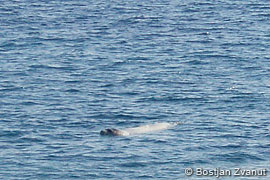 |
|
|
|
Tilen Genov, a representative of Morigenos, a Slovenian NGO dedicated to marine mammal research and conservation, has reported another confirmed monk seal observation at cape Kamenjak (near Pula) in Croatia.
The sighting, by Bostjan Zvanut, took place on 31 October 2009 at 13:30, the animal swimming approximately 50-100m from shore.
Although previously considered extinct in the Adriatic, sporadic sightings of the Mediterranean monk seal in Croatia are becoming more common. Two other photographed sightings also occurred at cape Kamenjak earlier this year [see Comeback sightings, TMG 12 (1): June 2009].
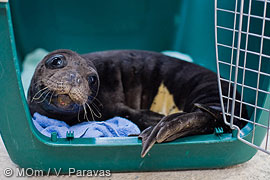 |
|
|
Orphaned monk seal Nefeli. |
An orphaned newborn monk seal was found stranded by local residents late in the afternoon of Wednesday the 14th of October, at Assos beach on Kefalonia, in the Ionian Sea. MOm’s Rescue team travelled immediately to the area and examined the 10-day old female pup, who remained abandoned at the beach, having lost her mother following severe storms.
The animal was found to be dehydrated and had visible superficial injuries, probably due to storm waves on the rocky coast.
The young seal was named “Nefeli” by local residents and volunteers, who found her helpless and stood guard overnight until MOm’s team arrived. MOm’s specialists provided first aid to Nefeli and, assisted by the Port Police officers of Fiskardo, prepared the pup for her immediate transfer to MOm’s Rescue and Rehabilitation Centre at Steni Vala, Alonissos, within the National Marine Park of Alonnisos, Northern Sporades.
Upon her arrival and the completion of the first veterinary tests, MOm’s staff, in collaboration with the Veterinary School of the University of Thessaloniki, introduced Nefeli to an intensive veterinary therapy and rehabilitation programme. The first critical phase includes the gradual provision of fish porridge, as there is still no substitute for mother’s milk for the Mediterranean monk seal.
The treatment and rehabilitation programme generally lasts approximately 5 months and, if completed successfully, the animal will be released in healthy condition back to its natural environment. The rescue, treatment and rehabilitation procedures all follow strict international protocols. The entire process is long and demanding both for Nefeli and the people involved, with veterinary tests, continuous treatment, round-the-clock feedings and hard physical work.
MOm would like to thank the Port Police Authority of Fiskardo and all the local supporters for their valuable contribution in the effort to rescue the newborn monk seal pup.
If you would like to support Nefeli’s rescue and treatment programme, please visit MOm’s website www.mom.gr. – Emily Joseph and Marianna Psaradellis, MOm.
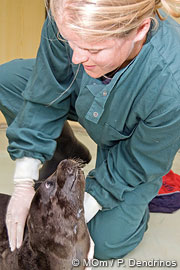 |
|
|
Emily Joseph with Nefeli. |
The staff of Mom’s Rehabilitation Centre in Alonnisos are pleased to report a successful first month for Nefeli. Though weak and underweight upon arrival, she has responded well to the centre’s nutrition protocols: her current diet of tuna “soup” has resulted in a steady weight gain and a current weight of 21 kilos. The arrival of nearly all of her teeth heralds a gradual change from soup to solid, de-boned tuna fillets and, eventually, other species of fish. Though the weight gain is encouraging, her latest round of blood tests were even more so, revealing that the animal is indeed healthy and doing well under the established protocols.
The first Mediterranean monk seal to arrive from the Ionian side of Greece, she has proved to be surprisingly strong for her size. She is an agile swimmer, who, even in her first days at the centre, would remain submerged for minutes at a time. She is also an adept huntress, catching fish even in her first encounters. Her pool is maintained with a rotating stock of enrichment activities including a toy designed for seal play, frozen octopus, and small schools of live fish. Nefeli now has access to the pool all day and will eventually have night access as well.
Moulting is progressing rapidly for the little seal: her stomach and chest have completely shed the lanugo coat and now the hairs on the back of her head, shoulders, and along her spine are changing over.
If all goes well, Nefeli will be ready to return to her natural environment in a few short months. She will be fitted with both a satellite tracking device and a flipper tag to aid in future identification. We hope that this time the world will prove a safer place for monk seals. – Emily Joseph, MOm.
Personnel of the National Marine Park of Alonissos, Northern Sporades (NMPANS), recorded an unusual monk seal behavioural observation during a routine check of caves on the island of Skopelos on 1 October 2009.
Although Skopelos lies outside the boundaries of the Park, its seal caves have traditionally been checked as part of the monitoring process of the area.
Nearing a cave on the island, which cannot be entered by boat because of a rock overhang, the biologist of the NMPANS, Vassilis Kouroutos, reported that he detected a smell of decay.
“Then very close to the beach of the cave, about 4 or 5 meters away, I saw something floating, and immediately recognised it as a dead pup. But then suddenly we also saw the mother inside the cave, so we thought we’d better leave to avoid disturbing her.
We returned about half an hour later, thinking that the mother would have left the cave by then. However, we could no longer see the pup anywhere inside the cave. We began searching around, but the pup was nowhere. Eventually we saw something floating under a kind of rock, to the right of the cave. And at the same time we heard the mother vocalising. So again we left the cave, since we didn’t want to disturb the mother.
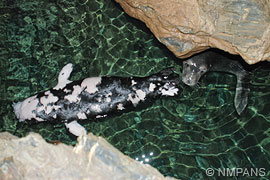 |
|
|
The female seal, keeping watch over her dead pup. |
Then from outside I spotted a hole in the cave that I could reach from the shore, and where I could watch what was happening inside. I stayed there for about three quarters of an hour. The mother was continually around the pup; with her nose, was always trying to hide the pup and was looking after it as though it was alive. It seems as though the mother must have been looking after it like this since its death, days before [its estimated birth date, 26 September]. In all the years that I have worked with seals, this is the first time that I have ever seen something like that. Although the mother could detect our presence inside the cave, she made no attempt to escape and come back later; no, she was always staying there, close to her pup, trying to hide it.
For us it was very difficult to retrieve the pup under those conditions; and so we said that we would return the next day and try again, hoping the mother would have left the cave by then.
We alerted MOm, who would be responsible for the necropsy, but the following day there were very strong winds from the south side, making entry to the cave very difficult. Because of the weather, I doubt if we shall find either the mother or the pup there anymore.”
Monitoring activities throughout the wider Marine Park area, carried out by the scientific team of the NMPANS Management Body, indicate a decrease in pup productivity during the 2009 breeding period.
This year, surveys showed a degradation of the monk seal shelters at Piperi island, the Park’s core zone, due to unexpectedly high sea levels reducing the size of cave beaches suitable for pup birthing and nursing.
Conversely, monk seal shelters on the S.E. coast of Skopelos, due to their morphology and structure, did not seem to be affected by the higher sea level and therefore retained their significant suitability as important monk seal breeding sites.
Until the middle of November 2009, five newborn pups – one of which was found dead (see news item above) – and six adult monk seals were observed in the wider area of the NMPANS.
The first pup was born at Piperi on 20 September, the only birth witnessed so far this year in the core zone of the Park, and the last on 10 October at Skopelos island.
During the 2009 breeding period, out of a total of 11 monk seals (newborn and adults), 3 were observed in Piperi and the rest (8) in Skopelos. This demonstrates once again the importance of the monk seal shelters located along the S.E. coast of Skopelos, which is still not part of the NMPANS protected area, despite the fact that it is included in the Natura 2000 Network. Bearing in mind that human disturbance (boat traffic, fishing, tourism etc) in these monk seal shelters is relatively high compared to those at Piperi, where human access is limited, this suggests that if monk seals have to choose between avoidance of human disturbance vs. shelter suitability their choice would be the latter – a network of breeding shelters safe from adverse weather conditions.
Until now (middle of November) the four pups are in excellent health, nursed and looked after by their mothers. In the case of the pup found dead, it was not possible to determine the cause of death. – Management Body of the National Marine Park of Alonnisos Northern Sporades.
MOm’s information centre in Patitiri, Alonnisos, in the National Marine Park of the Northern Sporades, is happy to report another successful year of its Seal School. The eleven-week interdisciplinary programme continues to grow each year, welcoming Greek tourists, local children, and visitors to its nightly programmes. Every night has a different theme, including two environmental lessons per week, one craft night, one night of group games, one night of games to help review school skills (grammar, maths, geography, etc), one volunteer-led night, and one “wild card” night (yoga, music, creative writing, juggling, etc).
New activities this year included a first-aid class, a fish dissection night, in-house recycling of the centre’s waste-paper, an exhibition on the impact of litter on the ocean environment, and a student-written and produced theatre. Social and emotional learning workshops were also introduced with the intention of helping children learn to establish positive relationships and handle challenging situations constructively. Ever popular are the monthly reading contests (which logged nearly 1,000 books); the “I Matter” programme, where the children make a weekly commitment to an environmental action such as conserving electricity; and the use of the centre’s computer for educational games.
Though the programme is not without its challenges, such as the cat who stole the hotdog from our solar oven or the occasional finger-paint stain on the centre’s white curtains, Seal School continues to grow thanks to the help of a wonderful team of volunteers and the enthusiasm of our students. We hope that participants leave with a sense of stewardship for the earth and its creatures and that they will go on to become responsible global citizens. – Emily Joseph, MOm.
Last April, MOm biologists Marianna Psaradellis and Emily Joseph travelled to Sausalito, California for a one-month internship at The Marine Mammal Center. The Center, a highly respected marine mammal hospital, treats hundreds of harbour seals, elephant seals, fur seals, sea lions, and other marine life each year.
Marianna, the new head of MOm’s rescue programme and Emily, who manages the rehabilitation centre in Alonnisos, gained many skills to help them in their new roles. In addition to helping volunteer crews with daily feeding and care of the animals, the girls were able to shadow the veterinary team, follow education programmes, take part in necropsies, learn the basic processes of biochemical analysis, and participate in a myriad of other activities at the Center. This year, the Center took in a record number of patients (1,500 so far this year) and the busy pace ensured that the girls were able to assist with and learn about an eclectic array of marine mammal diseases and blights.
The MOm biologists were also proud to serve as ambassadors for Monachus monachus, discussing the Monachus genus with several Hawaiian counterparts and sharing their experiences with volunteers and staff at the Center. “The Greeks” would like to extend their most sincere gratitude to all of the wonderful people at The Marine Mammal Center who made them feel at home and who passed on a wealth of knowledge and experience that can be put to great use for the critically endangered Mediterranean monk seal. – Emily Joseph and Marianna Psaradellis, MOm.
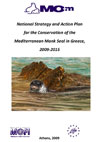 |
|
|
|
MOm (the Hellenic Society for the Study and Protection of the Monk Seal) has announced the publication of a national conservation strategy for the species to be implemented between 2009 and 2015.
Prepared by marine mammalogist Giuseppe Notarbaratolo di Sciara in association with MOm’s own researchers, the Strategy has now been submitted to the Greek authorities and the European Commission, in the hope that its various recommendations will be officially adopted and implemented.
“The plan contains one aim, four objectives and a series of actions for the next five years,” Notarbartolo di Sciara told the Italian press agency, ANSA [New rescue plan for rare seals]. “It has been designed for Greece, which is home to the largest population of this species, but the strategy is being drawn up in a way that would allow its export to all Mediterranean countries.”
MOm. 2009. Action Plan for the mitigation of the negative effects of monk seal ‐ fisheries interactions in Greece, Summary Report. MOm, WWF Greece, Fisheries Research Institute, 2009: 1-11. [PDF  2.9 MB]
2.9 MB]
Notarbartolo di Sciara, G., S. Adamantopoulou, E. Androukaki, P. Dendrinos, A.A. Karamanlidis, V. Paravas and S. Kotomatas. 2009. National strategy and action plan for the conservation of the Mediterranean monk seal in Greece, 2009 ‐ 2015. Report on evaluating the past and structuring the future. Publication prepared as part of the LIFE‐Nature Project: MOFI: Monk Seal and Fisheries: Mitigating the conflict in Greek Seas. Hellenic Society for the Study and Protection of the Mediterranean monk seal (MOm), Athens. 1-70. [PDF  3.4 MB]
3.4 MB]
EndQuoteA haven for wildlife and eco-conscious travelers National Marine Park of Alonissos protects both rare species and fish stocks Home to the Mediterranean monk seal (Monachus monachus), the waters around the island of Alonissos, in the Northern Sporades archipelago, have become a refuge for considerable fish populations, thanks to strict monitoring and a good relationship with local fishermen. “Aegean fish stocks are low and we are all to blame,” says Vangelis, a former fisherman. “But here, thanks to the National Marine Park, we still have fish.” A maritime paradise covering 2,220 square kilometers, the park covers not only Alonissos but six smaller islets (Peristera, Kyra Panagia, Psathoura, Piperi, Skantzoura and Youra) along with 22 rocky islets. […] The main achievement is that it has won the support of locals who realize its value in attracting visitors to Alonissos while protecting the environment.
National Intelligence Service officers are in Zakynthos to investigate the cause of a forest fire last Sunday that left more than 50 bathers trapped on Dafni Beach, where they were rescued by the coast guard. Police on the island suspect that the fire was a case of arson and is likely to have been linked to a dispute between some locals and the organization that manages a national marine park on Zakynthos.
|
Mediterranean News continues with Madeira, Mauritania & Western Sahara and Turkey...
Copyright © 2009 The Monachus Guardian. All Rights Reserved |